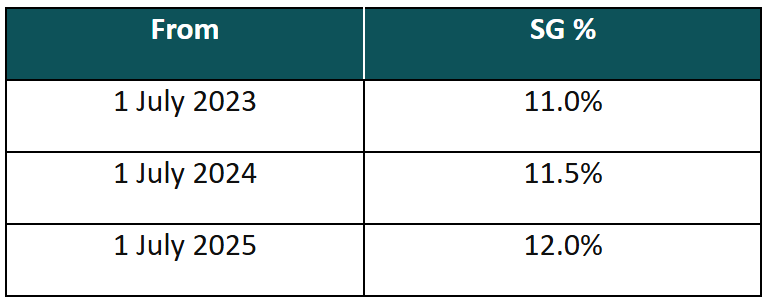From 1 July, employers’ obligations to pay superannuation on behalf of employees will be changing. It is critical to ensure your payroll system is up to date, as the penalties for missed employee superannuation obligations can be severe.
Increase in superannuation guarantee percentage
From 1 July, the Superannuation Guarantee percentage increases to 10.5% (up from 10%). The percentage is applied to an employee’s Ordinary Times Earnings. Note that the new percentage will apply to remuneration paid to employees on or after 1 July 2022, even if any part relates to work performed before 1 July.
The percentage will then increase each subsequent year as follows:
Abolition of $450 threshold
Ever since compulsory employer superannuation was introduced, where an employee earned less than $450 in a month from an employer, the employer had no requirement to pay the Superannuation Guarantee amount. This threshold is removed from 1 July 2022. Accordingly, employers will be required to contribute the Superannuation Guarantee amount for all employees, no matter how little the employee might earn from the employer in any particular month.
The removal of the $450 threshold might mean you\’ll be paying Superannuation Guarantee on behalf of some employees for the first time. In that case, you will need to provide to them the Standard Choice Form.
Payroll system
Employers need to ensure their payroll systems are updated so that contributions on behalf of all eligible employees are being made at the increased rate of 10.5% from 1 July 2022, and for every dollar of Ordinary Times Earnings, no matter how little that might be. All employers are required to have Single Touch Payroll (STP)-compliant payroll software.
Employers will need to ensure these changes are promptly implemented in order to avoid penalties for underpayments and/or late payments. For existing employees, employers need to check with their payroll system provider to ensure that the necessary steps are followed to update the existing employees’ details to ensure these changes are also applied to them. At 200%, the penalties for missing the Superannuation Guarantee payment deadlines are severe, on top of losing the entitlement to a tax deduction.
Next steps
If your payroll system is not STP-compliant or you are unsure about how to make the necessary changes to your payroll system, contact your Nexia Advisor or ask to speak to a Nexia Cloud Solutions team member, as they are expert in all industry standard payroll systems.







